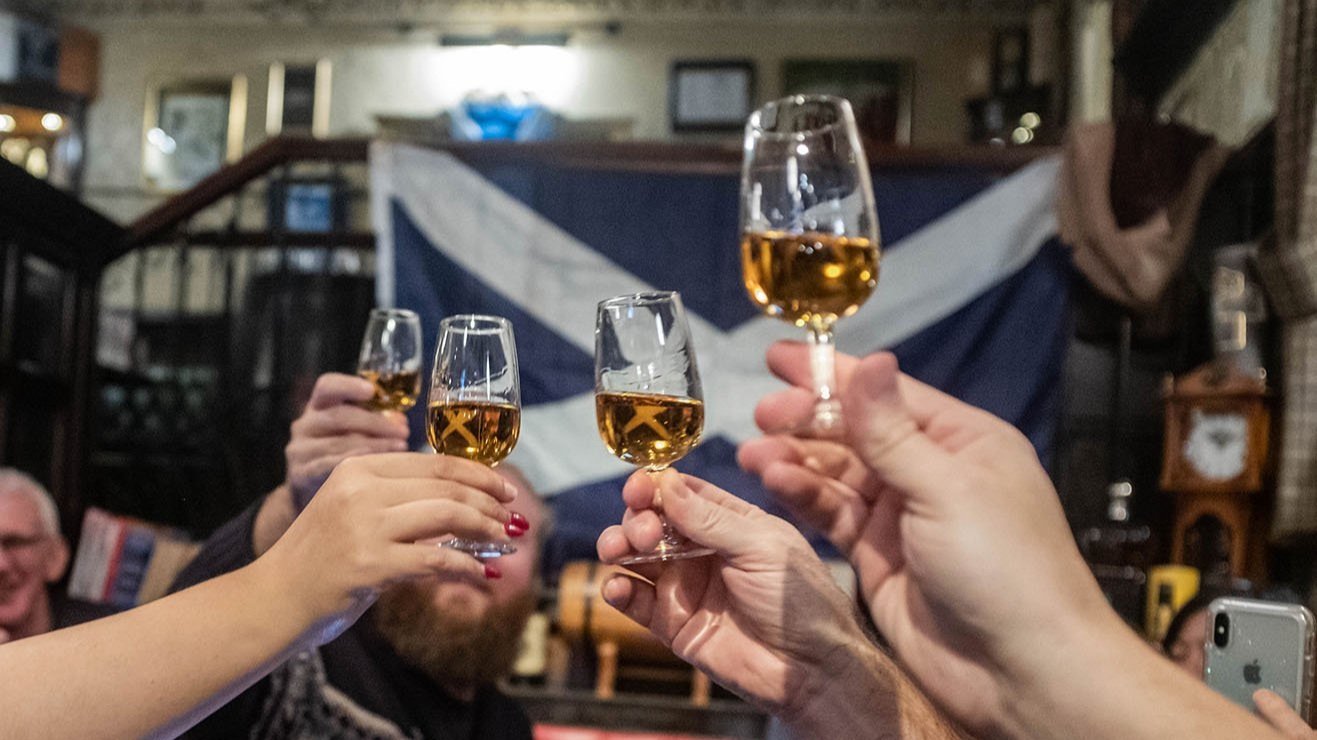Springbank 12yo Cask Strength Vertical
Four Official Batches | Various ABVs
Score: 9/10
Exceptional.
TL;DR
The Wee Toon in quintessential quadruplet form
Well, I managed to hold off thus far.
But think it’s time for the proverbial dam to break; let’s talk about Campbeltown.
To be clear, I don’t plan on recounting the plethora of socioeconomic and other miscellaneous maladies surrounding the area’s whisky culture, rather I’ll continue to write in the niche I’m comfortable with.
It should be said that many of the topics I want to cover have been covered just brilliantly by Wally in his Campbeltown Funk piece, and indeed I’ll be touching on aspects of said article. To start with, I think it’s worth trying to break down some of the elements that typify Campbeltown whisky. As I’ve said elsewhere, I’m not one for the ideals of terroir or even regional style, however there are some common threads that weave their way between the Campbeltown producers that I feel unite elements of their products. Firstly, with the exception of Hazelburn, they all use local peat; Campbeltown is a coastal peninsula, so it follows that these characteristics may transfer to their peat. Glen Scotia allegedly makes an unpeated (the vast majority of production), moderately peated and heavily peated new -make which are then matured and blended separately to give greater control down-line in level of apparent peating.
Secondly, the average fermentation time in Campbeltown is significantly longer than the industry average. Springbank and Glengyle allegedly use 72-110 hour fermentations (probably split into two distinct lengths like many distilleries, depending on time of the week) and some sources for Glen Scotia quote a monstrous 70-140 hours with the average falling in the 120s.
As touched on in my Ledaig review, even these minimum lengths are enough to see the lactobacilli culture blooming necessary to produce many of the fatty acids intrinsic to ester production. Another factor touched on in Wally’s article is that all three distilleries utilise fairly short stills, which both increases the copper surface area to vapour flux ratio and reduces fractionation - ie a higher rate of still transesterification via reflux and more low-volatility compounds such as fusel alcohols/oils (same thing), phenols, long chain aldehydes and ketones etc making their way to the condenser. This factor is particularly important for stills with downward angled lyne arms, such as those used at Springbank. While I’ve touched on the importance of fusel oil production for esterification previously, there’s another aspect to consider here in conditions with low fractionation, but first we must-away to a prerequisite tangent; phase separation.
Given any two or more liquids mixed in a solution at a fixed temperature, there are multiple phases they might occupy. The most common example of this is oils and water, which occupy two separate phases and are thus immiscible (at room temperature). If we introduce a third component, however, then things become more complex. For instance some oil, water, and ethanol mixtures. If the concentration of ethanol is high and the concentrations of oil and water are low, then the three liquids may become miscible and occupy a single phase. If the relative concentration of either oil or water creeps too high, however, then a second phase may separate out (i.e. a water-ethanol mixture and the oil). A handy visual tool to see where these points exist relative to various concentrations is the phase diagram.
Some of you may have heard of an old-school methodology based on this principle used by distiller’s called the misting test. This is a process whereby a sample collected from the condenser is diluted with water to 20% ABV. If the sample is ethanol high and fusel oil low, then at dilution there remains only one phase. However, around the point one might consider taking the cut from hearts to tails, the concentration of ethanol has diminished and the temperatures requisite for fusel oils to volatilise over the lyne arm has been achieved, so the spirit off the condenser might now have too high a fusel oil content to remain in a single phase when diluted. The result of this second phase formation causes the liquid to become hazy or misty, hence the name.
I focus on this mechanism specifically because it is important to wider distillation mechanics. For instance, it’s important that distillers clean their stills, lyne arms and condensers between distillations so that the fusel oils which form a film on the interior copper tubing are stripped away, otherwise they may taint subsequent distillations. This inspires a thought though; what about fusel oils coming through the late stages of the hearts? They have the potential to reduce copper contact through the lyne arm and condenser, which is by far the highest surface area to vapour flux point anywhere in distillation. And if any distillery is likely to see higher fusel oil content, shouldn’t it be one with long fermentations, less controllable heating like a direct fired still (if only the wash still) and a downward lyne arm? As much as reflux is an important contributor to volatile sulphur removal in distilling, much of the sulphur removal also happens in the condenser - hence why distilleries using worm tubs tend to have a “meatier” spirit. If the condenser is being coated with fusel oils, there is potential for reduced copper surface-area-time product.
As an aside, Glenfiddich have done experiments on copper contact efficiency with spirit in condensers by measuring the amount of copper in new-make spirit. The conclusion of these experiments was that condensers are more efficient when run hotter - delaying the point at which spirit condenses from vapour to liquid extends the surface-area-time product, as well as maintaining higher molecular energies during this time to catalyse the copper-sulfur reactions. These results have also been achieved and published elsewhere, such as the Institute of Brewing (Reaich D, 1999).
In any case, whether fusel oils play a part in this or not we should discuss the big S in a more meaningful way. It continues to be one of the most polarising issues in whisky drinkers, and for good reason. However, I think the issue is slightly larger than the likes of Jim Murray would have us believe. Sulfur can present itself in two overarching senses- cask derived and spirit derived. Reticent as I am to say it, I do tend to agree with Jim on the issue of cask sulfur. The problem here is molecular sulfur being dosed into the wood either through burnt sulfur candles or a citric acid/sulfur dioxide solution, which then leaches into whisky readily after filling. This is a real issue since the sulfur is not always detectable when nosing the empty casks, but the influence on the spirit is unmistakable. Struck match, flatulence, vulcanised rubber, however you want to play it it’s not pretty.
Another source of sulfured casks is spoilage microorganisms (bacteria and brettanomyces) which can foul a cask if not properly sanitised. This tends not to be an issue in casks which have previously held a spirit, since the alcohol concentrations kill the microorganisms. The exception here may exist in deconstructed and re-coopered casks, however most of these undergo re-toasting/re-charring which also controls spoilage. Some people have a higher sensitivity than others for these sulfur compounds, and some are even genetically blind to it, but for those that can pick it up it’s almost never good.
Spirit sulfur, however, is a much more flexible matter. The number of different sulfur molecules derived from malt (both the grain and malting processes) and yeast/bacterial fermentation is dizzying. Some of the compounds are transferred to new make directly from the grain (such as SMM and the resulting DMS) or from molecular sulfur used in malting to eliminate carcinogenic risks such as nitrosamines, which are converted into sulphur oxides. Much, though, is derived from yeast and or bacterial metabolism of the amino acids from malt protein, and to a lesser degree bacterial fermentation that occurs in the breakdown of vegetation during peat formation. Lactobacillus cultures also produce sulphur as part of amino acid metabolism from autolysed yeast cells, which becomes particularly significant after all residual sugars have been consumed- in other words, particularly late stage fermentation.
“All this might seem like a bit of overkill, but I think it’s a useful tool for looking into distillates like Springbank”
Anyway, let’s look at some compounds; firstly, there’s the simpler and more volatile chemicals which are usually stripped out from distillates with plenty of copper interaction; hydrogen sulphide, methanethiol and ethanethiol. Hydrogen sulphide is highly important as a reactant with copper, since literature indicates its reduction by an order of 100 through copper pot distillation. Then there are more complex compounds like dimethyl trisulfide (DMTS) and other di/trisulfides, which are counterintuitively formed by copper reaction with simpler compounds like methanethiol, but are also shown to be removed by copper interaction. The likely conclusion is these polysulphide groups have multiple origins, and those derived from copper reactions are a relatively minor source. DMDS and DMTS have both been shown to increase with higher temperatures and longer distillation times, so distilleries like Springbank utilising direct fired stills are likely prone to higher concentrations.
Other organosulphurs found in whisky from distillation and maturation reactions include thioesters (ester bonds substituting one or both oxygen atoms for a sulphur atom), thiophenes, benzothiophene and benzothiazole. Some sulphur compounds are lost during maturation, but for those that are retained I’ve included a quick and dirty (get it!) list below.
*Trace amounts may exist, difficult to find lab data for compound in fermentations presumably because of extremely low OAV value
There are other compounds that likely contribute to the overall “funk” we experience in Springbank and other similar style whiskies. Among them are the heterocyclic nitrogen-containing compounds which are formed by Maillard reactions. For example, pyrazines are formed by the Maillard reaction of two amino-ketones derived from the Strecker degradation of amino acids. These Maillard reactions occur during kilning of malt, but also during wash distillation when direct fired stills are utilised, such as those at Springbank. These reactions only occur in the wash still since both amino acids and carbohydrate sources (neither of which distil into the low wines) are required for Maillard reactions to take place. It’s worth noting that pyridines are also contributed to new make from peated malt. Below is another simplified table of these nitrogen compounds and their aroma contributions;
Most of these compounds are basic, and hence in sufficiently acidic conditions (such as those of longer aged whisky) these compounds can exist as protonated cations, thereby reducing their volatility. This reduced volatility means that at room temperature pyridines may not partition into the vapour phase and thus not contribute to aroma, only flavour. Pyrazines are less basic than pyridines, and thus are notably less affected by this mechanism, so may still contribute to aroma as well as flavour.
All this might seem like a bit of overkill, but I think it’s a useful tool for looking into distillates like Springbank. To my palate, I certainly detect many of the more pleasant qualities of the above compounds. While there are numerous compounds yet to discover and intangibles we’ll likely never put a name to, the sulfur and nitrogen containing components described above might go a long way to defining some of the characteristics we associate with Campbeltown funk, especially when taken into consideration along with the fusel oils, fruity esters and region specific peat. As usual, most of the information in this article and others has been sourced from Whisky Science, A Condensed Distillation. I can’t recommend it enough as an educational and reference text for these technical topics.
Right, let’s have some whisky shall we?
Review 1/4
Springbank Cask Strength Batch 20, 2020 Release, 55.3% ABV
Sold out at retail, availability subject to the usual insanity.
Score: 9/10
Exceptional.
TL;DR
Simply one of the most stunning whiskies I have had the pleasure to drink
Nose
Ultimate farmyard funk with lanolin, horse sweat and dung, grapefruit, tepache, worn leather, old geuze and pickled onion. The peat expresses chimney smoke, combusted diesel, soot, a touch of burnt hair and coastal brine. As it opens up it becomes more fermentary with ripe peaches, mango, baked red apple and lemon sorbet doused with chantilly cream courtesy of the bourbon casks.
Palate
Just wow. The room note from various Cuban cigars, polished boot leather, mild rubber, brettanomyces-heavy lambics, long-hung double smoked ham, passion fruit juice, bitter marmalade, antique furniture and light baking spices. Goes on with Maraska-filled dark chocolates, burnt raisins, sweet beef jus and tertiary sherry notes reminiscent of old Armagnac. The finish flits around between most of these notes for apparent aeons leaving a film of rich oily goodness.
The Dregs
This is simply one of the most stunning whiskies I’ve had the pleasure to drink. It exudes the complexity, charisma and tertiary tones that I imagine veterans of the industry might describe whisky from yesteryear possessing. Despite only 35% of the blend being sherry matured, this noses and drinks more sherry forward than the batch 22 in an extremely pleasing way. Perhaps others prefer different vintages of the 12CS or different expressions from the Springbank stable. Unfortunately I’m new enough to whisky that the batch 20 was the first expression available to me, so that’s as far back as this vertical stretches. That said, I have tried a batch 18 at a bar that was also excellent, but would suggest this 20 would still beat it for my preference. I debated internally over the scoring for this for a long time, but ultimately I paid a fair price for this and tasting it in a cultural vacuum, there’s really no other way to go.
Score: 9/10
Review 2/4
Springbank Cask Strength Batch 21, 2020 Release, 56.1% ABV
Review based on a shared bottle, sold out at retail.
Nose
Rubber, musty basement, teenage BO and slightly burnt hair, but there seems to be quite some contribution from the casks (45% sherry, 25% bourbon, 25% burgundy [red presumably] and 5% port). Some sour vinous tones with cherry cough syrup, figs, dates, even a little brandy-spirit grapiness and implications of rancio (marzipan and old linseed oil). The peat contributes good roast coffee beans, soot and a light coastal tincture of bromophenols and menthol.
Palate
Whew, the casks aren't as overdone as the nose suggested, which is to say they're only huge rather than gigantic. There's some nice fruit driven sweetness (see nose, add a few raisins, blackcurrants and strawberry) before the more familiar salt cured game meats, lemon oil, shoe polish, smoked mackerel, roasted peanuts and embrocations. The finish has some medium grippy tannins, and opens the pantry with fleetings of anise, thyme, cinnamon and clove alongside a moderate rancio.
The Dregs
This is more or less what I expected looking at the cask composition. There are few other distilleries that could put out a product with these specifications that would extract as much enjoyment from my picky palate. That said, compared to its brethren here the casks are ostensibly heavier set in the composition which to me at least is a mild detractor from the spirit quality. Still, a great dram that I’m sure many others have garnered significantly more pleasure from than I.
Score: 7/10
Review 3/4
Springbank Cask Strength Batch 22, 2021 Release, 55.4% ABV
Sold out at retail.
Score: 8/10
Something special.
TL;DR
the value for money decimates the vast majority of modern whisky
Nose
Compared to the previous batches, a slight drop in the funk factor. Globally quite similar tones of soot, fermented meats, brine, plentiful stinky tropical fruits, BBQ fish and mild rubber. Some nice cask contributions with butter menthols, salted caramel, vanilla pudding and berry compote. Time in glass unlocks more over-ripe and fermenting fruits.
Palate
The most tropical juicy fruits by a country mile- grilled pineapple, mango, passionfruit, papaya, lime, lychee and even hints of Trinidad rum. American oak lends coconut and vanilla to the tropical cocktail before we remember this in fact Springbank; continues with good biscuity malt, cod cooked over a charcoal grill, benzene and prosciutto. Delicate sherry cask coming forward late on with some dirty oranges, mixed red berries and mild fig. Very oily mouthfeel which lingers into the finish.
The Dregs
While the funk factor has taken a step back compared to the first two, the balance between spirit and casks is arguably on par with the batch 20. Another stellar bottling, the value for money (at retail of course) still decimates the vast majority of modern whisky. That said, it doesn’t quite contain the spark which, in my view, makes the batch 20 an icon in its field.
Score: 8/10
Review 4/4
Springbank Cask Strength Batch 23, 2021 Release, 55.9% ABV
Sold out at retail.
Score: 8/10
Something special.
TL;DR
another wonderful whisky, and I am immensely grateful
Nose
Well, this is probably the cleanest nosing Springbank I can remember. A relatively, coastal, chiselled and angular profile; more reminiscent of the early Kilkerran 8 bourbon CS than usual Springbank. Opens with a little chimney soot, kelp, chalk, some rice vinegar/mirin blend and tropical citrus between lime, grapefruit and yuzu peel. Time in glass yields good yeasty breads and grist, light but complimentary foostiness, herbes de provence and some sweet florals.
Palate
No seriously, can somebody pass the sashimi? The citrus is more geared to yuzu now with more umami and kokumi laden mirin plus some honeycomb, nutty coffee beans and mildly smoked salmon. Otherwise similar to the nose; coastal, tropical fruits, slightly acetic ferment, savoury smoke, malty, yeastiness with a mild foosty funk and some floral white stone fruits (apricot etc).
The Dregs
This has lower funk than even batch 22. It seems some sherry is needed to properly express the sulfur driven fermented meats, pickled onion, rubber etc typical of most Springbanks, but I must say I'm a sucker for the Kilkerran 8 and this does much of the same for me. I’m curious whether this is an indication of J&A Mitchell & Co utilising the odd sulfured sherry cask in the blending process or whether some organoleptic synergy effects are at play. Ah well, that’s a topic for another day and another article. Regardless, this is another wonderful whisky, and I am immensely grateful to be able to drink these liquids.
Slàinte!
Score: 8/10
Tried these? Share your thoughts in the comments below. TK
-
Dramface is free.
Its fierce independence and community-focused content is funded by that same community. We don’t do ads, sponsorships or paid-for content. If you like what we do you can support us by becoming a Dramface member for the price of a magazine.
However, if you’ve found a particular article valuable, you also have the option to make a direct donation to the writer, here: buy me a dram - you’d make their day. Thank you.
For more on Dramface and our funding read our about page here.














































